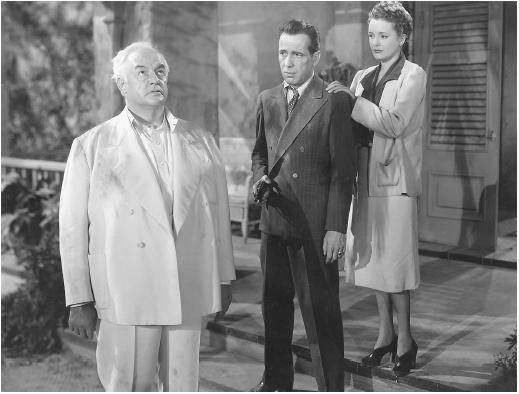
When
The Maltese Falcon (1941) became a huge success, Warner Brothers did what every movie studio in the past and present have done after a successful movie – tried to make a sequel.
The sequel to
The Maltese Falcon was supposed to have
Humphrey Bogart return as Sam Spade with
Mary Astor and
Sydney Greenstreet making appearances as well.
Unfortunately, the writers couldn’t come up with a good story for Spade and the idea was dropped.
Instead, it was replaced with a new story involving new characters, but the same actors. This movie would become Across the Pacific (1942). It is a war movie starring Bogie, Astor and Greenstreet. John Huston was signed on to direct and Peter Lorre even made an appearance on the set when the movie was shooting. It was a lot like the mean streets of San Francisco that were explored in the Falcon, except this time the major players were on a boat.
The original idea for the story, thought of in the late fall of 1941, was to involve a Japanese strike the U.S. forces located at Pearl Harbor. Of course Bogart was going to save the day just before the Japanese attack. A thing called history interfered with this storyline when the Japanese in fact attacked the American forces on December 7. Since the story’s location had to be changed, but not much else, the scriptwriters decided on the Panama Canal. Bogie famously remarked that production of the picture should begin as soon as possible “while we still have the Canal.”
With World War II many in Hollywood enlisted in the military. Bogart was not one of them. He had served at the end of World War I and was too old for service. Much like another famous actor who didn’t serve in World War II, John Wayne, this inability to fight for the United States made Bogie feel terrible. But like Wayne, Bogie was encouraged to win the war on film. And Bogie did just that in Across the Pacific.
The movie begins with Bogie being court-martialed because he stole some money from the Navy. In disgrace, Bogie moves out of the United States and tries to get into the Canadian army. They won’t take him. So Bogie figures the only way he can use his skills as an artilleryman is to go to Japan and see if they need him. He books a passage on a boat bound for the orient.
When he gets on he meets Sydney Greenstreet, who is a professor specializing in the Oriental culture. Also on the ship is Mary Astor, who claims to be a girl from Medicine Hat looking for an adventurous vacation in the Orient.
Of course we soon learn that Bogie is secretly working for the U.S. government, that Greenstreet is plotting for the Japanese and that Astor is not as innocent as she claims to be.
Eventually the boat is stopped at the Panama Canal. Since it is unable to go through, the passengers disembark. Ironically, Panama happens to be a place where Bogie was stationed with the Navy. Greenstreet tries his best to destroy the Panama Canal, while Bogie resists his temptations of money and eventually saves the day.
This is a standard World War II war movie. It includes many great actors. But the story behind it is more interesting. The fact that the original location was going to be Pearl Harbor. Also John Huston was signed as the director, but midway through shooting the picture he was called off to join the Army’s Signal Corps. Vincent Sherman finished shooting the movie, but Huston was the only one to get screen credit for being the director.


No comments:
Post a Comment